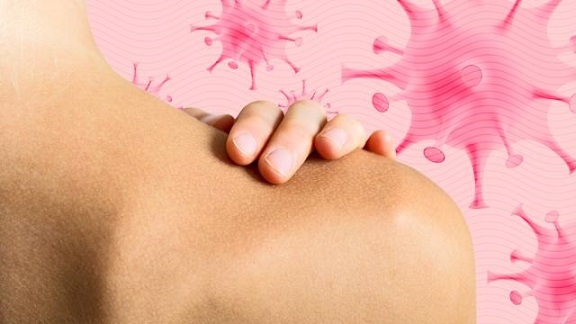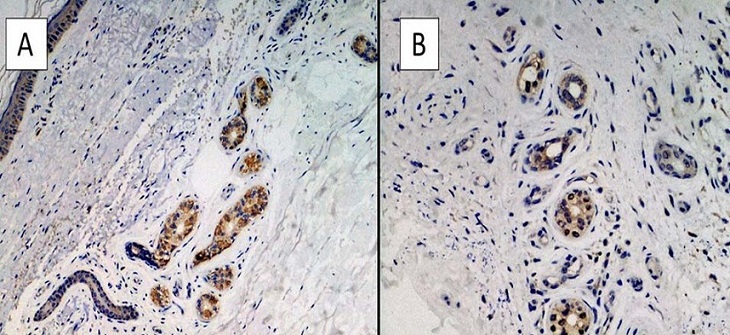BREAKING! Italian Study Claims That SARS-CoV-2 Could Possibly Penetrate The Skin Through The Eccrine Sweat Glands!
Source: Medical News-SARS-CoV-2-Skin Sep 05, 2022 3 years, 3 months, 1 week, 4 days, 4 hours, 31 minutes ago
Italian researchers from the University of Bari “Aldo Moro”, University of Turin, the FPO-IRCCS Candiolo Cancer Institute and the Pathology Unit at Fondazione IRCCS Casa Sollievo della Sofferenza in new study have found that the SARS-CoV-2 virus could possibly penetrate the skin through the eccrine sweat glands!

The current ongoing SARS-CoV-2 crisis has disrupted global health systems and brought the entire world to its knees. Though initially thought to be a disease of the respiratory system, COVID-19 can affect different parts of the body, including the skin.
Case studies and reports of ongoing skin manifestations of COVID-19 have gradually multiplied, pushing scientists to investigate the etiopathogenic mechanisms underlying these phenomena in more depth.
The study team in an attempt to investigate the possible association between SARS-CoV-2, ACE2, TMPRSS2 and skin manifestations, performed immunohistochemical investigations of the ACE2 receptor and TMPRSS2 in nine skin samples from SARS-CoV-2-positive patients compared to a cohort of healthy controls.
Also, after consulting public databases regarding ACE2 mRNA expression in various cell populations resident in the skin, the study team conducted a literature review aimed at outlining the current state of this topic.
The study findings did not indicate statistically different immuno-expression of ACE2 and TMPRSS2 between the group of SARS-CoV-2-positive patients (nine skin biopsies) and the control group.
As for the ACE2, major immunolabeling was present in the epidermal keratinocytes and, rarely, in the fibroblasts and in the adenomeres of the eccrine sweat glands.
As for the the immune expression of TMPRSS2, the study team found no significant differences between the two groups, with a weak immune staining only in some skin cytotypes.
From the review of the literature, the study team isolated 35 relevant articles according to the inclusion criteria adopted. ACE2 appears to be a target of SARS-CoV-2, although, other receptor molecules may potentially be implicated, such as TMPRSS2.
The study team said that more detailed studies with large cases and different molecular investigative methods are warranted to further elucidate the mechanisms underlying the skin manifestations of SARS-CoV-2.
Corresponding author, Dr Gerardo Cazzato from the Section of Molecular Pathology, Department of Emergency and Organ Transplantation (DETO), at the University of Bari “Aldo Moro” told Thailand
Medical News, “The study findings indicate that the SARS-CoV-2 could possibly penetrate through the skin via the ACE2 receptors found in the fibroblasts and the adenomeres of the eccrine sweat glands!”
The study findings were published in the peer reviewed journal: biomolecules.
https://www.mdpi.com/2218-273X/12/9/1212
Despite initial discovery that SARS-CoV-2 infections were found to mostly affect the lower and upper airways along with the lungs, several extrapulmonary manifestations involving the kidney, intestine, skin, brain, heart, liver, and placenta have been reported thereafter.
/>
As with regards to the skin, various eruption patterns affect both children and adults worldwide.
Some of the common cutaneous manifestations associated with COVID-19 were erythematous rashes, livedoid lesions, acro-ischemia, pseudo-chilblains, or cutaneous manifestations resembling erythema elevatum diutinum, pityriasis rosea, Grover disease, and erythema multiforme.
The ACE-2 or Angiotensin-converting enzyme (ACE2) receptor is a transmembrane protein enzyme that plays an integral role in the renin-angiotensin-aldosterone system (RAAS). Angiotensin I, which is obtained from the liver, is converted by ACE to angiotensin II, which is further cleaved to angiotensin 1–7 and finally helps in inflammation and vasodilation.
The ACE2 receptor is important in mediating SARS-CoV-2 infection. ACE2 binds to the receptor-binding domain (RBD) of the S1 SARS-CoV-2 protein, while S2 carries out the fusion of the host and viral cell membrane. This is followed by the expression of transmembrane serine protease 2 (TMPRSS2) and transcription of viral proteins that generates multiple virions and helps spread disease.
Expression of ACE2 has been reported in various parts of the body. However, studies on their expression at the skin level are relatively low.
 Histological preparation for immunostaining with anti-SARS-CoV-2 S1 spike protein monoclonal antibody in a patient of the positive group. Note the granular, cytoplasmic positivity at the level of the cells constituting the eccrine sweat glands (IHC, Original Magnification: 10× and 40×).
Histological preparation for immunostaining with anti-SARS-CoV-2 S1 spike protein monoclonal antibody in a patient of the positive group. Note the granular, cytoplasmic positivity at the level of the cells constituting the eccrine sweat glands (IHC, Original Magnification: 10× and 40×).
The study team analyzed the possibility of penetration of SARS-CoV-2 into the skin. It also studied the expression of TMPRSS2 as well as carried out a review of the current literature to determine pathways that related ACE-2 expression to SARS-CoV-2 outcomes.
The research involved the collection of skin biopsy samples from SARS-CoV-2 positive patients as well as controls between 16th May 2020 and 11th May 2021.
All clinical data, along with COVID-19 severity, was also collected from the patients. The symptoms were considered mild, including cough, fever, headache, malaise, altered taste, and myalgia. Symptoms were considered moderate if there was evidence of pneumonia and/or oxygen saturation (SaO2) was equal to or greater than 94%. Symptoms were considered severe if the SaO2 was less than 94% or there were symptoms of respiratory failure.
For the study, the expression of TMPRSS2 and ACE2 was determined using anti-ACE2 and anti-TMPRSS2 monoclonal antibodies and immunohistochemistry scores where a chromogen signal was highlighted in the cell membrane and/or cytoplasm. Different scores were assigned based on the degree of staining intensity.
The subsequent meta-analysis of published literature was carried out utilizing the Web of Sciences (WoS) and PubMed with the help of specific keywords such as COVID, Coronavirus, skin, rash with ACE2, and RAAS. Only those articles that were published in English were selected.
The detailed extraction of data was carried out by two investigators. All the selected articles were assessed using the Oxford Centre for Evidence-Based Medicine 2011 guidelines.
The study findings indicated a strong S1 glycoprotein positivity at the excretory portion of the eccrine sweat glands as well as the endothelium of small blood vessels.
The expression of SARS-CoV-2 was found to be greater in keratinocytes, while a significant signal was also found at the adenomeres of the eccrine sweat glands. Expression of ACE2 mRNA was also observed in the skin tissues.
It was however noted that the majority of keratinocytes were found to be negative forTMPRSS2.
In the meta-analysis, a total of 33 publications were included in the study. Most of them comprised reviews followed by original articles and case series. Additionally, all the included studies were rated as level 4 or 5 in the Oxford Center for Evidence-Based Medicine 2011 guidelines for clinical research.
The current study findings demonstrated that SARS-CoV-2 was directly able to cause infection through the eccrine sweat glands.
Several authors however do not align with the findings of this study. Moreover, this study could not confirm whether COVID-19 is capable of causing dermatological symptoms.
Hence the study tea collectively says that further studies utilizing larger populations are required to determine this aspect of the pandemic accurately.
It was also noted that one prominent limitation of the current study is that although the immuno-expression of TMPRS22 and ACE2 could explain the direct penetration of the virus, it cannot explain the basis of SARS-CoV-2 rashes.
For the latest
SARS-CoV-2 Research, keep on logging to Thailand
Medical News.

